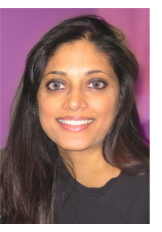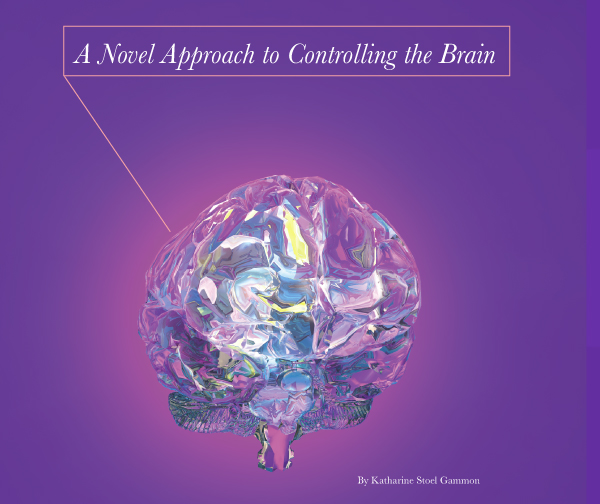While Sridevi Sarma was a post-doc in the prestigious neuroscience lab led by Emery Brown in the Brain and Cognitive Sciences department at MIT, she met a roadblock. She was trying to design a better way to build a controller for Deep Brain Stimulation (DBS), which as an engineer felt comfortable to her, but she was frantic to learn the techniques of her new discipline, Neuroscience. Techniques of Dr. Brown's lab had broken barriers in understanding the neurophysiology of animals and humans while they are conscious and mobile. However, these methods were not enough to help Sridevi achieve her goals. She sought out her old LIDS advisor, Munther Dahleh, who gave her a piece of vital advice. "He just said stop -- stop what you're doing. Use your systems and control approach and don't forget it. That's the new thing that only you bring to the table."
Sridevi said that those words have stuck with her ever since. "I was just following their bandwagon and hitting all the same roadblocks that neuroscientists hit in understanding DBS." But once she started thinking in the framework of control systems – whether it was for an airplane or for brain-implanted electrodes, her perspective changed and she was able to merge her education from Brain and Cognitive Sciences with what she learned at LIDS.
Sridevi's path to brain-implant controller design started during the time she was doing her doctoral studies in LIDS. Though her graduate studies were focused on control theory, she was taking courses in neuroscience on the side – "We had to do a minor in something, but I really wasn't looking to do anything interdisciplinary," she says.
A class project, though, led her to do a three-day case study on her aunt who had early-onset Parkinson's disease. In those three days, she gained a completely different perspective of what it's like to live with Parkinson's disease, and what it's like to be the spouse of someone with it. Sridevi saw an opening to put her training to use in finding a better way to help people with neurological disorders. "I was motivated to better understand what's happening in the brain, to use my training in systems modeling and control to better understand the brain, and how to design better therapy."
Now an assistant professor in the Biomedical Engineering Department and in the Institute for Computational Medicine at Johns Hopkins University, Sridevi works on optimizing a controller for DBS, a procedure during which an electrode is surgically implanted in the brain and sends electrical impulses to specific parts of the brain. The impulses can be targeted in such a way that they are able to alleviate some symptoms of movement disorders, including those induced by Parkinson's disease.
"The way it's done now is very heuristically," said Sridevi. DBS will work if two things are done correctly – if the doctor implants the electrode in the correct place, and if the correct electrical signal is injected. While most people have a good understanding of the target, she says, getting the signal exactly right for each person is very difficult.
Most doctors who work with Deep Brain Stimulation do their best to adjust the instrumentation, but it's essentially a shot in the dark. "After the patient recovers from surgery, the doctor literally tweaks the parameters of the stimulator," she said, adding that while the pulse train of current that goes into the electrodes is constant, the intensity and frequency of the pulse can be tweaked. Sridevi says that doctors typically ask patients to walk around the room and perform certain motor tasks while the pulse's parameters are changed. Not only is this process laborious, it's also expensive and lengthy – it can take up to a year figure out the best way to optimize DBS treatment for each patient.
Sridevi's goal is to create a more intelligent system for both placing and controlling the electrode signals. Currently, once the parameters are correct, she says, the same high-power signal runs 24 hours a day, 7 days a week – until the batteries run out three to five years later. At this point another surgery and another round of tweaks are required. Plus, the electrical impulses can trigger other circuits in the brain, making patients anxious or depressed.
Sridevi thinks it's possible to re-imagine the whole system. The normal brain operates in a low power, and she thinks that there is a low-power alternative for Deep Brain Stimulation. She also thinks that the electrical signal can be designed to work smarter. "DBS should intelligently adapt to the patient's state, on-medication/off-medication, awake and during sleep, across all stages of the disease," she said. "We want to get an intelligent chip sitting in there, measuring appropriate activity, and responding accordingly so that the patient's brain looks more like a healthy brain."
She is now analyzing neural data from normal primates and primates induced with Parkinsonian symptoms via a neurotoxin, to build systems level models of healthy and diseased neural circuits with and without Deep Brain Stimulation. The systems approach and computational framework she brought from LIDS can be both exciting and challenging to neuroscience colleagues who have a set way of doing things. "LIDS gave me the systems perspective – the methodology and tools to apply to this field. I really have not run across anyone with my training looking at these problems," she said.
Some parts of her new role are different from her time at LIDS, though. For one, there are patients involved. "Unlike LIDS, where you have definitions, a problem statement, and theorems, my metric here is that something I invent has to work in a patient. They just want a solution. When I talk about what we're doing, it's got to be results-oriented," she said.
Sridevi hopes that within ten years, one of the approaches for Deep Brain Stimulation she's working on finds its way into clinical trials. "One project is focused on Parkinson's Disease, and the other on Epilepsy. I would feel great if any one of my approaches makes its way to clinical trials," she said, adding that the goal is realistic, assuming everything falls into place today.
As for her aunt with Parkinson's, Sridevi has kept in touch, sending her some papers and discussing Deep Brain Stimulation with her. "She does have DBS, and we've talked about what it's doing in her brain. The thing with her is that she's now in her 50s, and she has very late-stage Parkinson's. She's gone through just about every possible therapy including ablative surgery and bi-lateral DBS, but she hasn't completely regained quality of life."
LIDS has helped Sridevi in many ways in envisioning her research. "In particular, the technical training I got at LIDS was stellar. I can say I have always understand the technical details of all the research talks I go to." Munther Dahleh's advice still sticks with her. "Everything we're doing is novel because of our approach. I think we are making lots of headway in both the Parkinson's problem and also in detecting seizures in drug-resistant epileptics." When she gets to bring a new approach to an old problem, Sridevi is putting her training to use for the good of many.




